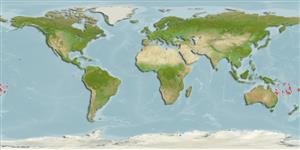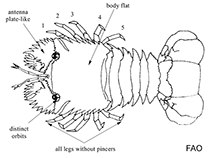Parribacus caledonicus Holthuis, 1960
Caledonian mitten lobster| Native range | All suitable habitat | Point map | Year 2050 |

|
| This map was computer-generated and has not yet been reviewed. |
| Parribacus caledonicus AquaMaps Data sources: GBIF OBIS |
Upload your photos
Google image | No image available for this species;
drawing shows typical species in Scyllaridae.
Google image | No image available for this species;
drawing shows typical species in Scyllaridae.
Classification / Names Common names | Synonyms | CoL | ITIS | WoRMS
Malacostraca | Decapoda | Scyllaridae
Environment: milieu / climate zone / depth range / distribution range Ecology
Benthic; depth range 0 - 20 m (Ref. 101290). Tropical; 9°S - 26°S, 150°E - 169°W (Ref. 4)
Distribution Countries | FAO areas | Ecosystems | Occurrences | Introductions
Central Pacific: from Queensland, Australia to Samoa.
Length at first maturity / Size / Weight / Age
Maturity: Lm ? range ? - ? cm Max length : 18.0 cm BL male/unsexed; (Ref. 4)
It has lengths of 18 cm, maximum total body length; between 4.5 and 8 cm, carapace length (Ref. 4). Minimum depth range from Ref. 122059. It is found in shallow water on reefs, usually on the exposed side, often in surge channels. They hide in crevices and marine caves in the day time, often attached to the ceilings of the caves (Ref. 4). In general, scyllarids are mainly carnivorous scavengers preferring small benthic invertebrates (Ref. 106995). Its congener Parribacus antarcticus appears to be an invertebrate generalist while other scyllarids are observed to become specialized for feeding on bivalves (Ref. 106996).
Life cycle and mating behavior Maturity | Reproduction | Spawning | Eggs | Fecundity | Larvae
Members of the order Decapoda are mostly gonochoric. Mating behavior: Precopulatory courtship ritual is common (through olfactory and tactile cues); usually indirect sperm transfer.
Main reference
References | Coordinator | Collaborators
Holthuis, L.B. 1991. (Ref. 4)
IUCN Red List Status (Ref. 130435)
Least Concern (LC) ; Date assessed: 03 December 2009
CITES status (Ref. 108899)
Not Evaluated
CMS (Ref. 116361)
Not Evaluated
Threat to humans
Human uses
Fisheries: commercial
| FishSource | Sea Around Us
Tools
More information
Internet sources
BHL | BOLD Systems | CISTI | DiscoverLife | FAO(Publication : search) | Fishipedia | GenBank (genome, nucleotide) | GloBI | Gomexsi | Google Books | Google Scholar | Google | PubMed | Tree of Life | Wikipedia (Go, Search) | Zoological Record
Estimates based on models
Preferred temperature
(Ref. 115969): 24.7 - 28.9, mean 26.7 (based on 321 cells).
Nutrients: Calcium = 109 [35, 184] mg/100g; Iron = 1.59 [1.21, 1.97] mg/100g; Protein = 20.2 [19.2, 21.3] %; Omega3 = 0.285 [0.185, 0.386] g/100g; Selenium = 48.3 [-31.7, 128.3] μg/100g; VitaminA = 0 μg/100g; Zinc = 1.79 [1.17, 2.40] mg/100g (wet weight).



